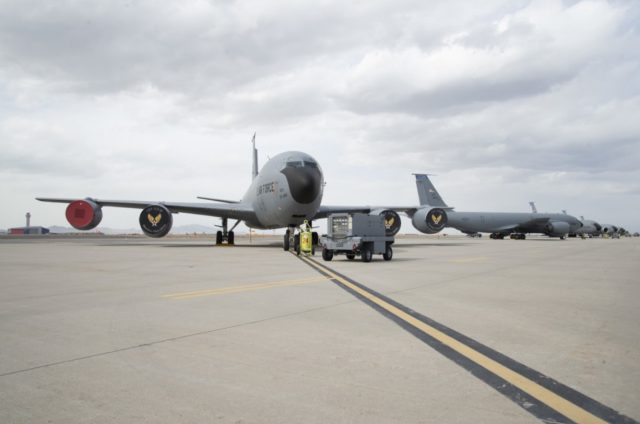A US Air Force KC-135 tanker piloted by airmen from the Air National Guard and the Air Force Reserves passed an important integration and modernization milestone during a recent flight from the Utah Air National Guard Base.
During the flight, the total force crew tested for any electromagnetic spectrum interference between the aircraft’s navigation system and tactical datalinks (TDL) in an effort to highlight the KC-135’s readiness to serve a bigger role of the Air Force’s innovative Advanced Battle Management System (ABMS) architecture.
The latest test is part of a series of flights conducted to verify real-time information in the cockpit system (RTIC) project upgrades, which will bring the aircraft into the 21st century and revolutionize the tanker’s role in combat. The Link 16, Situational Awareness Datalink (SADL) and Secure Beyond Line of Sight communications upgrades allowed one of the modernized Stratotankers to carry out a first test flight with a “loyal wingman” drone earlier this year.
The total force team, consisting of members from the 151st and the 927th Air Refueling Wings (ARW) of the Utah National Guard and MacDill AFB respectively, conducted Real Time In Cockpit (RTIC) tests to confirm that there was no interference between the LINK-16 radio system and the Tactical Air Navigation (TACAN) system.
The LINK-16 is a tactical datalink system used by most fighter jets and command and control platforms for encrypted data communication in combat environments, and the TACAN system is the range and bearing navigation source used for instrument flight. These two platforms work on the same frequency, and it is vital they do not interfere with each other in order to ensure the reliability of the communication and navigation sources.
“Electromagnetic interference would give erroneous navigation indication to the crew that could potentially draw the aircraft off its required course,” said Maj. Travis Posey, 927 ARW Weapons and Tactics Flight commander, and a KC-135 pilot. “We want our aircraft to operate where they are expected and not crash into other aircraft, obstacles, or terrain.”
Satellite communications enable JREAP-A protocol to communicate with Command and Control (C2) agencies, which is used in all forms of operation to combat and combat support. Enabling encrypted C2 beyond the line of sight ensures continuity of operations and enables the operating picture to be understood even when aircraft are not in line-of-sight communication. This reduces the fog and friction of operations.
“We did not know what the actual range was of this system due to antenna placement, radio capabilities, and ground station placement,” Posey said. “We exceeded our expectations and can achieve TDL communications beyond most voice radio communications we currently have between our aircraft and base command posts.”
According to a recent Department of the Air Force white paper, the Advanced Battle Management System (ABMS) initiative is designed to generate decision superiority by delivering relevant information and capabilities to warfighters and operators at all echelons.
ABMS, which is the top modernization priority for the air force with a budget of $3.3 billion over five years, will be the backbone of a network-centric approach in partnership with all the services across the defense department.
While not a single machine, sensor, or aircraft, the ABMS’s system of systems – or warfighting ecosystem – will streamline the many pathways for data to move around the globe. Through tactical edge communication nodes and advanced beyond-line-of-sight technologies, ABMS promises to shorten the data loop from days and hours to minutes and seconds.
The air force envisions the KC-135 as one of the critical nodes in the ABMS system, with 42 percent of total force KC-135s residing in the ANG.
The Air National Guard Air Force Reserve Test Center (AATC) is working on modifying two KC-135s using the MPRS outer mold-line pods with an internal open-architecture to ensure additional space for a host of ABMS and defensive technologies.
Tentatively called the Gladiator Pod, the system is expected to be equipped on a few KC-135 aircraft by fiscal year 2023 for flight testing. AATC plans on equipping the pod with the necessary sensors capable of detecting, identifying, tracking, and defending as a data node within ABMS.



























